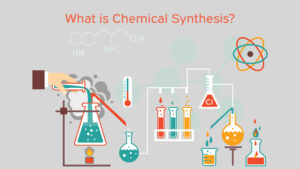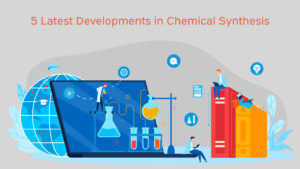Ever wondered about the alchemical transformations that bring everyday products to life? What if I told you that behind the makeup of materials we encounter daily lies the intricate art and science of chemical synthesis?
In this exploration of the fascinating world of chemical synthesis, we’ll delve into the latest developments, and grasp the transformative power of molecules at the heart of countless innovations.
Let’s get started!
What is Chemical Synthesis?

Chemical synthesis involves intentionally carrying out chemical reactions to obtain one or more products. This is achieved through physical and chemical manipulations, often involving multiple reactions. In contemporary laboratory practices, the process implies that the process is reproducible, dependable, and proven to be effective in various laboratory settings.
It involves selecting specific reagents, which undergo various reactions in a vessel to produce the desired product. Work-up procedures and yield measurement are crucial aspects, with side reactions potentially impacting the final product’s quantity.
Basically, it is the artful process of creating new substances through the meticulous orchestration of synthesis chemical reactions. At its core, chemical synthesis involves transforming reactants into desired products, a journey depicted by the synthesis chemical equation. These equations serve as the visual roadmap for chemists, detailing the precise arrangement and quantity of atoms involved in the reaction. Whether crafting pharmaceuticals, polymers, or innovative materials, the process stands as a fundamental pillar in the realm of chemistry, where creativity and precision converge to yield transformative results.
Overall, chemical synthesis reactions are the responses that occur when a new compound is formed by combining various existing substances. These reactions are commonly observed in both industrial environments and academic chemistry labs, and they play a significant role in everyday life.
Also Read: The Role of Cybersecurity Analytics in Threat Detection and Incident Response
5 Latest Developments in Chemical Synthesis

Listed below are the cutting-edge advancements in chemical synthesis, from innovative biocatalysts to the integration of renewable energy sources, driving greener and more efficient processes.
1. C-H Functionalization
C-H functionalization, a potent technique for modifying carbon-hydrogen bonds, streamlines synthesis, reduces steps, and minimizes waste. Recent catalytic advancements allow selective activation and functionalization of traditionally inert C-H bonds. Transition metal catalysts like a 2021 palladium catalyst and radical chemistry showcased in a 2020 visible-light-promoted reaction offer promising avenues. This evolving research area holds the potential for synthesizing intricate molecules with significant implications across fields, from materials science to drug discovery.
2. Flow Chemistry
Flow chemistry, utilizing continuous reagent pumping through a reactor, allows precise control of reaction conditions, enabling efficient synthesis of complex molecules. Its advantages include high-temperature and pressure reactions, overcoming limitations of traditional batch methods. Flow chemistry excels in sensitive reactions, such as those to oxygen or moisture, challenging in batch reactors. It is applied to diverse transformations like organometallic reactions and biocatalysis, wherein it showcases rapid development.
In 2021, researchers achieved a swift and selective synthesis of pharmaceutical-relevant molecules using a flow reactor. Overall, flow chemistry represents a growing field, promising improved efficiency and sustainability in chemical manufacturing, facilitating the synthesis of intricate molecules.
3. Machine Learning in Chemical Synthesis
Machine learning transforms chemical synthesis by predicting outcomes and optimizing reactions. In catalyst design, it balances factors like reactivity and stability, streamlining the process. Researchers employ machine learning to design catalysts for specific reactions, enhancing yield and selectivity. Additionally, it aids in creating molecules with desired properties, accelerating drug discovery by screening large databases for optimal candidates. This evolving field holds promise for expediting the discovery of drugs and materials, minimizing time and costs in the process.
4. Photocatalysis
Photocatalysis uses light energy to drive chemical reactions, allowing for mild conditions and reduced energy consumption. It finds applications in organic synthesis, energy conversion, and environmental remediation. Recent advances focus on efficient photocatalysts, including metal-organic frameworks and semiconductor nanoparticles like titanium dioxide. This rapidly evolving field holds promise for innovative processes in chemistry and materials science.
5. Sustainable Synthesis
Sustainable synthesis minimizes the environmental impact of chemical processes, emphasizing efficiency and safety. Key principles include high atom economy, green solvents, renewable feedstocks, and process intensification. Recent advances focus on biocatalysts and renewable energy sources, offering greener alternatives to traditional methods. This rapidly evolving research area holds significant potential for more sustainable and efficient chemical processes.
Summing It Up
A key component of contemporary chemistry, chemical synthesis is essential to many branches of research and technology, including materials science, medicine development, energy conversion, and environmental cleanup. The goal of recent advances in this field has been to employ novel methods and technologies—such as C-H functionalization, flow chemistry, machine learning, photocatalysis, and sustainable synthesis—to increase productivity, selectivity, and sustainability.
These developments could pave the way for the creation of novel and highly effective chemical processes, which would have far-reaching effects on numerous branches of research and technology. We can anticipate further developments and breakthroughs in the years to come as research in this field continues to advance, leading to promising discoveries and uses to improve society and the environment.




